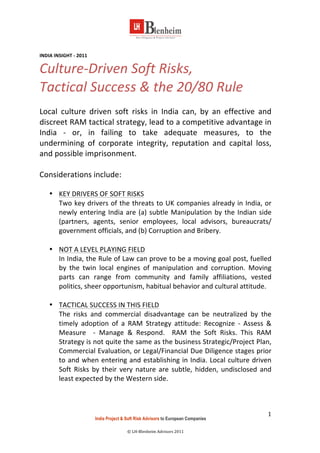More Related Content
Similar to The 20:80 Rule For India
Similar to The 20:80 Rule For India (20)
The 20:80 Rule For India
- 1.
India Project & Soft Risk Advisors to European Companies
©
LH-‐Blenheim
Advisors
2011
1
INDIA
INSIGHT
-‐
2011
Culture-‐Driven
Soft
Risks,
Tactical
Success
&
the
20/80
Rule
Local
culture
driven
soft
risks
in
India
can,
by
an
effective
and
discreet
RAM
tactical
strategy,
lead
to
a
competitive
advantage
in
India
-‐
or,
in
failing
to
take
adequate
measures,
to
the
undermining
of
corporate
integrity,
reputation
and
capital
loss,
and
possible
imprisonment.
Considerations
include:
• KEY
DRIVERS
OF
SOFT
RISKS
Two
key
drivers
of
the
threats
to
UK
companies
already
in
India,
or
newly
entering
India
are
(a)
subtle
Manipulation
by
the
Indian
side
(partners,
agents,
senior
employees,
local
advisors,
bureaucrats/
government
officials,
and
(b)
Corruption
and
Bribery.
• NOT
A
LEVEL
PLAYING
FIELD
In
India,
the
Rule
of
Law
can
prove
to
be
a
moving
goal
post,
fuelled
by
the
twin
local
engines
of
manipulation
and
corruption.
Moving
parts
can
range
from
community
and
family
affiliations,
vested
politics,
sheer
opportunism,
habitual
behavior
and
cultural
attitude.
• TACTICAL
SUCCESS
IN
THIS
FIELD
The
risks
and
commercial
disadvantage
can
be
neutralized
by
the
timely
adoption
of
a
RAM
Strategy
attitude:
Recognize
-‐
Assess
&
Measure
-‐
Manage
&
Respond.
RAM
the
Soft
Risks.
This
RAM
Strategy
is
not
quite
the
same
as
the
business
Strategic/Project
Plan,
Commercial
Evaluation,
or
Legal/Financial
Due
Diligence
stages
prior
to
and
when
entering
and
establishing
in
India.
Local
culture
driven
Soft
Risks
by
their
very
nature
are
subtle,
hidden,
undisclosed
and
least
expected
by
the
Western
side.
- 2.
India Project & Soft Risk Advisors to European Companies
©
LH-‐Blenheim
Advisors
2011
2
• LIFE-‐CYCLE
The
RAM
Strategy
is
a
crucial
effort
by
western
decision-‐makers
and
risk
officers
to
recognize
and
deal
with
soft
risks
that
arise
continually
throughout
the
life
cycle
of
entering,
establishing,
dealing
and
operating
in
India.
As
long
as
local
partners,
agents,
advisors
and
government
officials
are
to
be
interfaced.
The
RAM
response
can
shift
the
power
balance
away
from
the
local
parties,
allowing
focus
on
real
business.
• COMPETITIVE
ADVANTAGE
Knowledge
of
the
underlying
manipulation
and
actions
of
these
parties
can
convert
the
commercial
disadvantage
into
a
competitive
advantage
by
providing
a
choice
of
responses
to
balance
self-‐
protection
and
preserving
the
local
relationship
and
opportunity.
• PREVENTION
OF
REPUTATION
AND
CAPITAL
LOSS
An
apparently
healthy
P&L
account
from
the
India
venture
is
a
failure
if
reputation
loss
arises
from
underlying
manipulation
by
local
parties
and
corruption.
Quite
often,
the
local
party
may
count
on,
and
even
arrange
covertly,
the
threat
to
reputation
loss
to
induce
a
shift
of
position.
Trial
of
media
is
an
increasingly
common
tool
in
the
local
arsenal,
and
the
western
side
easily
manipulated,
leading
to
threat
of
a
double
blow
by
the
home
country
media.
• CORPORATE
INTEGRITY
&
THE
UK
BRIBERY
LAW
2011
Manipulation
in
India
leading
to
involvement
in
corruption
and
bribery
by
local
parties
(partners,
agents,
employees,
advisors)
can
potentially
lead
to
strict
liability
in
the
form
of
imprisonment
and
hefty
penalties
for
UK
directors
under
the
new
proposed
UK
Bribery
Act.
• 20/80
INDIA
RULE
Experience
of
doing
business
in
India
and
achieving
local
cultural
insights
will
indicate:
20%
of
the
total
effort
in
entering
and
succeeding
in
India
will,
if
applied
to
paying
attention
to
local
soft
risk
scenarios,
inevitably
yield
80
%
of
the
success
in
the
Indian
Venture.
